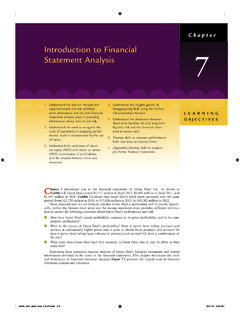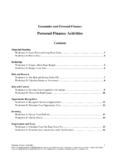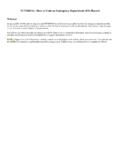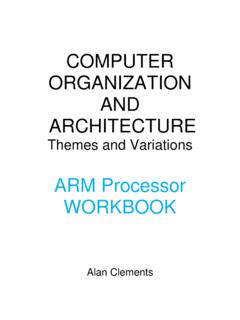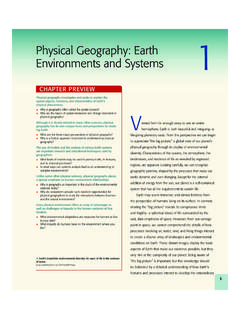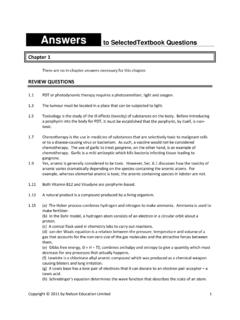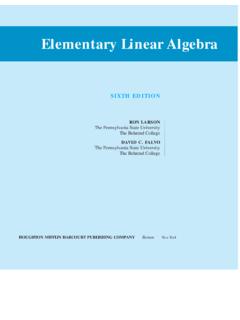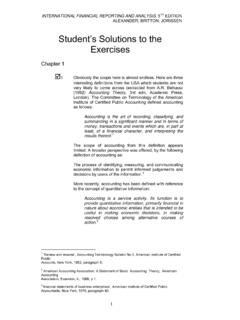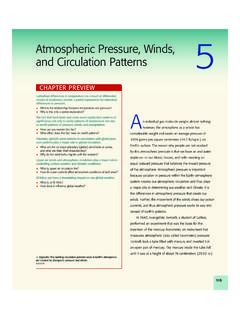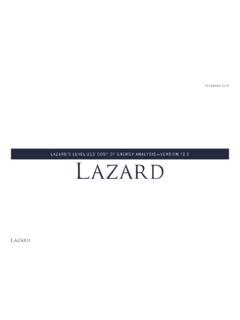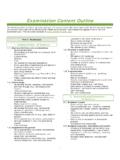Transcription of 17: Multinational Cost of Capital and Capital Structure
1 Copyright 2009 Cengage Learning. All Rights Reserved. May not be copied, scanned, or duplicated, in whole or in : Multinational cost of Capital and Capital StructureAn MNC fi nances its operations by using a Capital Structure (proportion of debt versus equity fi nancing) that can minimize its cost of Capital . By minimizing the cost of Capital used to fi nance a given level of operations, fi nan-cial managers minimize the required rate of return neces-sary to make the foreign operations feasible and there-fore maximize the value of those specific objectives of this chapter are to: explain how corporate and country characteristics influence an MNC s cost of Capital , explain why there are differences in the costs of Capital among countries, and explain how corporate and country characteristics are considered by an MNC when it establishes its Capital on cost of CapitalA fi rm s Capital consists of equity (retained earnings and funds obtained by issuing stock) and debt (borrowed funds).
2 The fi rm s cost of retained earnings refl ects an op-portunity cost : what the existing shareholders could have earned if they had received the earnings as dividends and invested the funds themselves. The fi rm s cost of new common equity (issuing new stock) also refl ects an opportunity cost : what the new shareholders could have earned if they had invested their funds elsewhere instead of in the stock. This cost exceeds that of retained earnings because it also includes the ex-penses associated with selling the new stock (fl otation costs).The fi rm s cost of debt is easier to measure because the fi rm incurs interest ex-penses as a result of borrowing funds. Firms attempt to use a specifi c Capital struc-ture, or mix of Capital components, that will minimize their cost of Capital .
3 The lower a fi rm s cost of Capital , the lower is its required rate of return on a given proposed project. Firms estimate their cost of Capital before they conduct Capital budgeting be-cause the net present value of any project is partially dependent on the cost of the Costs of Equity and DebtA fi rm s weighted average cost of Capital (referred to as kc) can be measured askc5aDD1 Ebkd112t21aED1 Ebkewhere D amount of the fi rm s debt kd before-tax cost of its debt t corporate tax rate E fi r m s e q u i t y ke cost of fi nancing with 4728/21/07 2:41:13 AM8/21/07 2:41:13 AMCopyright 2009 Cengage Learning. All Rights Reserved. May not be copied, scanned, or duplicated, in whole or in 17: Multinational cost of Capital and Capital Structure 47321NL47 These ratios refl ect the percentage of Capital represented by debt and equity, is an advantage to using debt rather than equity as Capital because the in-terest payments on debt are tax deductible.
4 The greater the use of debt, however, the greater the interest expense and the higher the probability that the fi rm will be un-able to meet its expenses. Consequently, the rate of return required by potential new shareholders or creditors will increase to refl ect the higher probability of tradeoff between debt s advantage (tax deductibility of interest payments) and its disadvantage (increased probability of bankruptcy) is illustrated in Exhibit As the exhibit shows, the fi rm s cost of Capital initially decreases as the ratio of debt to total Capital increases. However, after some point (labeled X in Exhibit ), the cost of Capital rises as the ratio of debt to total Capital increases. This suggests that the fi rm should increase its use of debt fi nancing until the point at which the bankruptcy prob-ability becomes large enough to offset the tax advantage of using debt.
5 To go beyond that point would increase the fi rm s overall cost of of Capital for MNCsThe cost of Capital for MNCs may differ from that for domestic fi rms because of the following characteristics that differentiate MNCs from domestic fi rms: Size of fi rm. An MNC that often borrows substantial amounts may receive prefer-ential treatment from creditors, thereby reducing its cost of Capital . Furthermore, its relatively large issues of stocks or bonds allow for reduced fl otation costs (as a percentage of the amount of fi nancing). Note, however, that these advantages are due to the MNC s size and not to its internationalized business. A domestic corporation may receive the same treatment if it is large enough. Nevertheless, a fi rm s growth is more restricted if it is not willing to operate internationally.
6 Be-cause MNCs may more easily achieve growth, they may be more able than purely domestic fi rms to reach the necessary size to receive preferential treatment from creditors. Access to international Capital markets. MNCs are normally able to obtain funds through the international Capital markets. Since the cost of funds can vary among markets, the MNC s access to the international Capital markets may allow it to obtain funds at a lower cost than that paid by domestic fi rms. In addition, cost of CapitalDebt RatioXExhibit Searching for the Appropriate Capital 4738/21/07 2:41:19 AM8/21/07 2:41:19 AMCopyright 2009 Cengage Learning. All Rights Reserved. May not be copied, scanned, or duplicated, in whole or in Part 4: Long-Term Asset and Liability ManagementSSNL74subsidiaries may be able to obtain funds locally at a lower cost than that available to the parent if the prevailing interest rates in the host country are relatively Coca-Cola Co.
7 S recent annual report stated: Our global presence and strong capi-tal position afford us easy access to key financial markets around the world, enabling us to raise funds with a low effective cost . This posture, coupled with the aggressive management of our mix of short-term and long-term debt, results in a lower overall cost of borrowing. The use of foreign funds will not necessarily increase the MNC s exposure to exchange rate risk since the revenues generated by the subsidiary will most likely be denominated in the same currency. In this case, the subsidiary is not relying on the parent for fi nancing, although some centralized managerial support from the parent will most likely still exist. International diversifi cation. As explained earlier, a fi rm s cost of Capital is af-fected by the probability that it will go bankrupt.
8 If a fi rm s cash infl ows come from sources all over the world, those cash infl ows may be more stable because the fi rm s total sales will not be highly infl uenced by a single economy. To the extent that individual economies are independent of each other, net cash fl ows from a portfolio of subsidiaries should exhibit less variability, which may reduce the probability of bankruptcy and therefore reduce the cost of Capital . Exposure to exchange rate risk. An MNC s cash fl ows could be more volatile than those of a domestic fi rm in the same industry if it is highly exposed to exchange rate risk. If foreign earnings are remitted to the parent of an MNC, they will not be worth as much when the dollar is strong against major currencies.
9 Thus, the capability of making interest payments on outstanding debt is reduced, and the probability of bankruptcy is higher. This could force creditors and share-holders to require a higher return, which increases the MNC s cost of Capital . Overall, a fi rm more exposed to exchange rate fl uctuations will usually have a wider (more dispersed) distribution of possible cash fl ows in future periods. Since the cost of Capital should refl ect that possibility, and since the possibility of bank-ruptcy will be higher if the cash fl ow expectations are more uncertain, exposure to exchange rate fl uctuations could lead to a higher cost of Capital . Exposure to country risk. An MNC that establishes foreign subsidiaries is subject to the possibility that a host country government may seize a subsidiary s assets.
10 The probability of such an occurrence is infl uenced by many factors, including the attitude of the host country government and the industry of concern. If assets are seized and fair compensation is not provided, the probability of the MNC s going bankrupt increases. The higher the percentage of an MNC s assets invested in foreign countries and the higher the overall country risk of operating in these countries, the higher will be the MNC s probability of bankruptcy (and therefore its cost of Capital ), other things being equal. Other forms of country risk, such as changes in a host government s tax laws, could also affect an MNC s subsidiary s cash fl ows. These risks are not necessarily incorporated into the cash fl ow projections because there is no reason to believe that they will arise.
